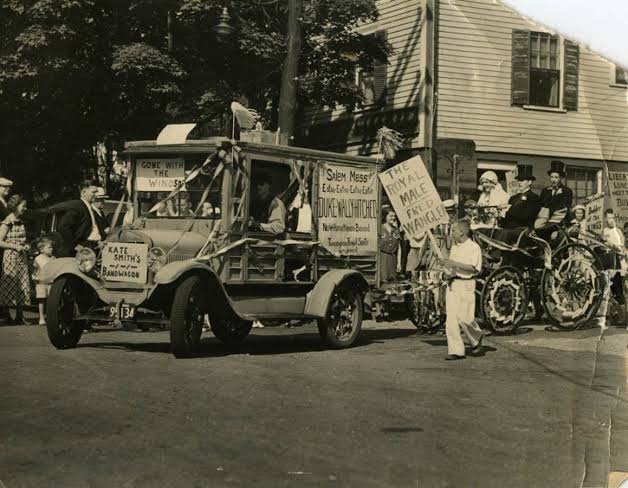On July 5, 1920, Portland, Maine, became the vibrant heart of celebration during the Maine Centennial, marking 100 years since the state’s admission to the Union. The event was a grand spectacle, filled with jubilant parades, extravagant floats, and a deep sense of community pride. One of the standout features of the day was the “Parade of Horribles and Antiques,” a unique and lighthearted tradition that captured the whimsy and creative spirit of the participants.
The Parade of Horribles and Antiques was a true reflection of the local character, blending humor, nostalgia, and competition. The procession, filled with individuals in eccentric costumes and displaying an array of antique items, brought a playful atmosphere to the Centennial celebrations. In this parade, participants weren’t just marching—they were making a statement. They competed for prizes in various categories, ranging from “Best Couple” to “Funniest Female” and “Most Original Costume,” allowing everyone to showcase their creativity and humor.
The participants in the Parade of Horribles and Antiques had one central mission: to entertain and to outdo each other in terms of originality. While some contestants wore outlandish costumes, others showcased bizarre or nostalgic antiques that perhaps had been passed down through generations. It was a celebration of Maine’s history, its people, and the lighter side of life. The idea behind the parade was to embrace a sense of absurdity—hence the title “Parade of Horribles,” which could refer to anything from comically exaggerated costumes to the playful mishmash of historical relics.
Among the most memorable entries in the parade was a couple who combined multiple motifs in their attire. The woman wore an old-fashioned dress, paired with a large clock hanging around her neck. Her partner wore a mask that obscured his features, creating an air of mystery and intrigue. Together, they became a striking image of the quirky spirit that defined the event. The clock, an antique piece, not only tied into the theme of the parade but also signified the passage of time, tying into the Centennial theme of reflecting on Maine’s century-long history. The couple’s outfit blended humor and nostalgia, offering a humorous commentary on the speed of time and the timelessness of fun.
The judges of the Parade of Horribles and Antiques, three respected community members, had the task of awarding prizes to the most impressive participants. The criteria were simple: the most creative, amusing, and original costumes won the day. The “Best Couple” category was hotly contested, with numerous duos turning up in coordinated costumes that ranged from satirical takes on historical figures to whimsical animal pairings. There was also the “Most Original Costume” category, which showcased the best of innovative designs, many incorporating elements of Maine’s past.
For the female marchers, the competition was fierce for the “Funniest Female” title. Many women donned oversized outfits or ingeniously designed hats, playing with proportions and textures to get a laugh from the crowd. The focus was on exaggerated, sometimes downright silly, expressions of fashion and identity—nothing too serious. Participants were encouraged to playfully ridicule the fashions of the past or make light of social conventions. This playful subversion of expectations brought a carefree energy to the parade, inviting everyone to let loose and laugh together.
The Parade of Horribles and Antiques was a shining example of the community’s spirit, not only showcasing Maine’s history but also the people’s creativity, humor, and unity. The event reminded spectators of the importance of celebrating both the serious and the silly aspects of life, especially when marking a significant occasion such as the Maine Centennial.
What stood out most about the parade was its inclusivity. People of all ages and backgrounds took part, from young children to elderly residents, each adding their own unique flavor to the event. It was a testament to how Maine’s people valued their heritage, while also embracing the importance of fun and levity in public celebrations.
In conclusion, the Parade of Horribles and Antiques on July 5, 1920, was more than just a quirky display of costumes and antiques it was an essential part of the Maine Centennial festivities. It reflected the community’s creative spirit, offered a delightful mix of nostalgia and humor, and provided a platform for everyone to take part in the celebration, no matter their age or background. The quirky parade stood as a symbol of how history can be celebrated in ways that are both reflective and joyful, a moment of lightheartedness amid the festivities that made the Maine Centennial truly unforgettable.


